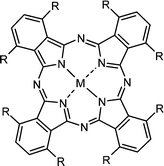The third-order nonlinear optical properties of a series of 15 unmetallated and metallated 1,4,8,11,15,18,22,25-octaalkylphthalocyanines have been investigated. The palladium-metallated compound is the strongest nonlinear absorber of the series, but, due to its comparatively high linear absorption coefficient, it exhibits a relatively low ratio of excited- to ground-state absorption cross-sections (κ) when compared to the other compounds. The highest values for κ were found for derivatives metallated with indium and lead. The nickel-metallated compounds are the weakest nonlinear absorbers, indicating that they are unsuitable as potential materials for practical passive optical limiters. Phenomenologically, the data for κ and the saturation energy density (Fsat) were found to follow trends dependent upon the linear absorption coefficient. This may have some implications for the design of phthalocyanines for nonlinear optical applications.
You have access to this article
 Please wait while we load your content...
Something went wrong. Try again?
Please wait while we load your content...
Something went wrong. Try again?


 Please wait while we load your content...
Please wait while we load your content...